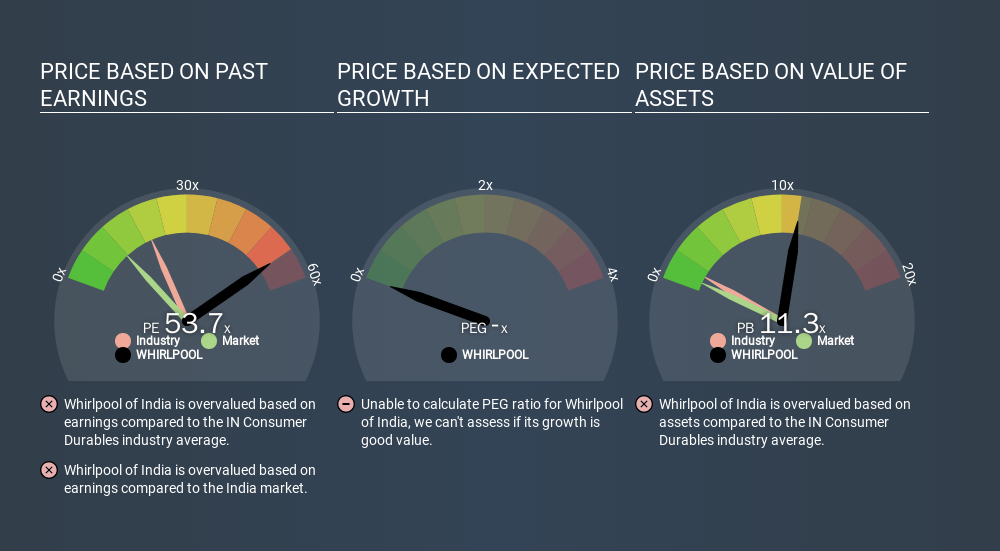- India
- /
- Consumer Durables
- /
- NSEI:WHIRLPOOL
Here's What Whirlpool of India Limited's (NSE:WHIRLPOOL) P/E Is Telling Us

The goal of this article is to teach you how to use price to earnings ratios (P/E ratios). We'll look at Whirlpool of India Limited's (NSE:WHIRLPOOL) P/E ratio and reflect on what it tells us about the company's share price. Based on the last twelve months, Whirlpool of India's P/E ratio is 53.71. That corresponds to an earnings yield of approximately 1.9%.
View our latest analysis for Whirlpool of India
How Do I Calculate Whirlpool of India's Price To Earnings Ratio?
The formula for price to earnings is:
Price to Earnings Ratio = Price per Share ÷ Earnings per Share (EPS)
Or for Whirlpool of India:
P/E of 53.71 = ₹2129.350 ÷ ₹39.645 (Based on the year to December 2019.)
(Note: the above calculation results may not be precise due to rounding.)
Is A High Price-to-Earnings Ratio Good?
A higher P/E ratio implies that investors pay a higher price for the earning power of the business. All else being equal, it's better to pay a low price -- but as Warren Buffett said, 'It's far better to buy a wonderful company at a fair price than a fair company at a wonderful price'.
Does Whirlpool of India Have A Relatively High Or Low P/E For Its Industry?
The P/E ratio essentially measures market expectations of a company. You can see in the image below that the average P/E (19.9) for companies in the consumer durables industry is lower than Whirlpool of India's P/E.

That means that the market expects Whirlpool of India will outperform other companies in its industry. The market is optimistic about the future, but that doesn't guarantee future growth. So investors should delve deeper. I like to check if company insiders have been buying or selling.
How Growth Rates Impact P/E Ratios
Generally speaking the rate of earnings growth has a profound impact on a company's P/E multiple. If earnings are growing quickly, then the 'E' in the equation will increase faster than it would otherwise. That means even if the current P/E is high, it will reduce over time if the share price stays flat. So while a stock may look expensive based on past earnings, it could be cheap based on future earnings.
Whirlpool of India increased earnings per share by a whopping 28% last year. And earnings per share have improved by 21% annually, over the last five years. With that performance, I would expect it to have an above average P/E ratio.
A Limitation: P/E Ratios Ignore Debt and Cash In The Bank
The 'Price' in P/E reflects the market capitalization of the company. That means it doesn't take debt or cash into account. Hypothetically, a company could reduce its future P/E ratio by spending its cash (or taking on debt) to achieve higher earnings.
Such spending might be good or bad, overall, but the key point here is that you need to look at debt to understand the P/E ratio in context.
Whirlpool of India's Balance Sheet
Since Whirlpool of India holds net cash of ₹18b, it can spend on growth, justifying a higher P/E ratio than otherwise.
The Bottom Line On Whirlpool of India's P/E Ratio
With a P/E ratio of 53.7, Whirlpool of India is expected to grow earnings very strongly in the years to come. With cash in the bank the company has plenty of growth options -- and it is already on the right track. So it is not surprising the market is probably extrapolating recent growth well into the future, reflected in the relatively high P/E ratio.
When the market is wrong about a stock, it gives savvy investors an opportunity. People often underestimate remarkable growth -- so investors can make money when fast growth is not fully appreciated. Although we don't have analyst forecasts shareholders might want to examine this detailed historical graph of earnings, revenue and cash flow.
But note: Whirlpool of India may not be the best stock to buy. So take a peek at this free list of interesting companies with strong recent earnings growth (and a P/E ratio below 20).
If you spot an error that warrants correction, please contact the editor at editorial-team@simplywallst.com. This article by Simply Wall St is general in nature. It does not constitute a recommendation to buy or sell any stock, and does not take account of your objectives, or your financial situation. Simply Wall St has no position in the stocks mentioned.
We aim to bring you long-term focused research analysis driven by fundamental data. Note that our analysis may not factor in the latest price-sensitive company announcements or qualitative material. Thank you for reading.
About NSEI:WHIRLPOOL
Whirlpool of India
Manufactures and markets home appliances in India and internationally.
Flawless balance sheet with reasonable growth potential.
Market Insights
Community Narratives



